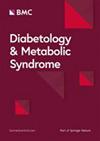Causal influence of immune factors on the risk of diabetic retinopathy: a mendelian randomization study
IF 3.4
3区 医学
Q2 ENDOCRINOLOGY & METABOLISM
引用次数: 0
Abstract
Diabetic retinopathy (DR) is a prevalent microvascular complication in diabetic patients. Various mechanisms have been implicated in the pathogenesis of DR. Previous studies have observed the relationship between immune factors and DR, but the causal relationship has not been determined. We conducted a two-sample Mendelian randomization (MR) analysis of 731 immune cells and DR, using publicly available genome-wide association study (GWAS) summary statistics, to evaluate potential causal relationships between them. Four types of immune traits were included in the analysis through flow cytometry. GWAS statistics for DR were obtained from the Finngen database, which performed GWAS on 190,594 European individuals (Ncase = 14,584, Ncontrol = 176,010) to assess genetically predicted DR. The primary method used to perform causality analysis was inverse variance weighting (IVW). Following false discovery rate (FDR) correction, 11MFI-DR, 5AC-DR, 5RC-DR, and 1MP-DR reached a significant causal association level (PFDR < 0.05). Notably, all AC traits exhibited potential associations with a decreased risk of DR(OR < 1), while a majority of MFI traits, along with the singular MP trait, exhibited potential associations with an increased risk of DR (OR > 1). The highest proportion of T-cell subsets in the final results. This study elucidates that the progression of DR is intricately influenced by immune responses, thereby confirming the immunological susceptibility of DR. Our findings may offer new targets for diagnosing and treating DR, as well as aid in developing therapeutic strategies from an immunological standpoint.免疫因素对糖尿病视网膜病变风险的因果影响:泯灭随机研究
糖尿病视网膜病变(DR)是糖尿病患者常见的微血管并发症。糖尿病视网膜病变的发病机制多种多样。以往的研究已观察到免疫因素与 DR 之间的关系,但尚未确定两者之间的因果关系。我们利用公开的全基因组关联研究(GWAS)汇总统计数据,对 731 个免疫细胞和 DR 进行了双样本孟德尔随机化(MR)分析,以评估它们之间的潜在因果关系。该分析通过流式细胞术纳入了四种类型的免疫特征。DR的全基因组关联研究统计数据来自Finngen数据库,该数据库对190594名欧洲个体(Ncase = 14584,Ncontrol = 176010)进行了全基因组关联研究,以评估遗传预测的DR。进行因果关系分析的主要方法是反方差加权法(IVW)。经过错误发现率(FDR)校正后,11MFI-DR、5AC-DR、5RC-DR 和 1MP-DR 达到了显著的因果关联水平(PFDR < 0.05)。值得注意的是,所有 AC 性状都表现出与 DR 风险降低的潜在关联(OR 1)。在最终结果中,T 细胞亚群的比例最高。这项研究阐明了 DR 的进展受到免疫反应的复杂影响,从而证实了 DR 的免疫易感性。我们的发现可能会为诊断和治疗 DR 提供新的目标,并有助于从免疫学角度制定治疗策略。
本文章由计算机程序翻译,如有差异,请以英文原文为准。
求助全文
约1分钟内获得全文
求助全文
来源期刊

Diabetology & Metabolic Syndrome
ENDOCRINOLOGY & METABOLISM-
CiteScore
6.20
自引率
0.00%
发文量
170
审稿时长
7.5 months
期刊介绍:
Diabetology & Metabolic Syndrome publishes articles on all aspects of the pathophysiology of diabetes and metabolic syndrome.
By publishing original material exploring any area of laboratory, animal or clinical research into diabetes and metabolic syndrome, the journal offers a high-visibility forum for new insights and discussions into the issues of importance to the relevant community.
 求助内容:
求助内容: 应助结果提醒方式:
应助结果提醒方式:


